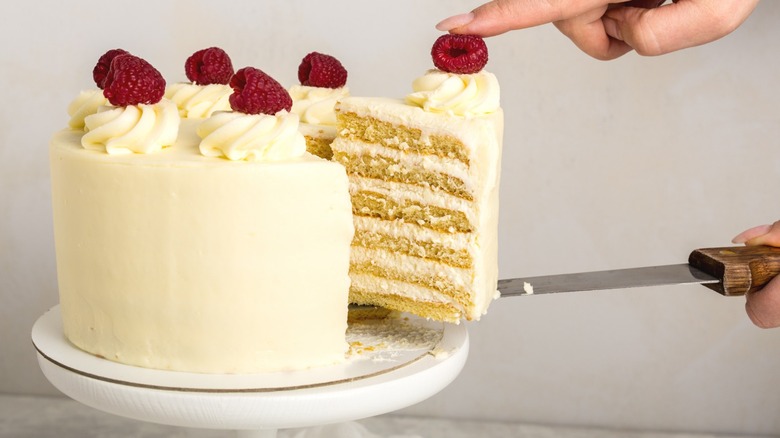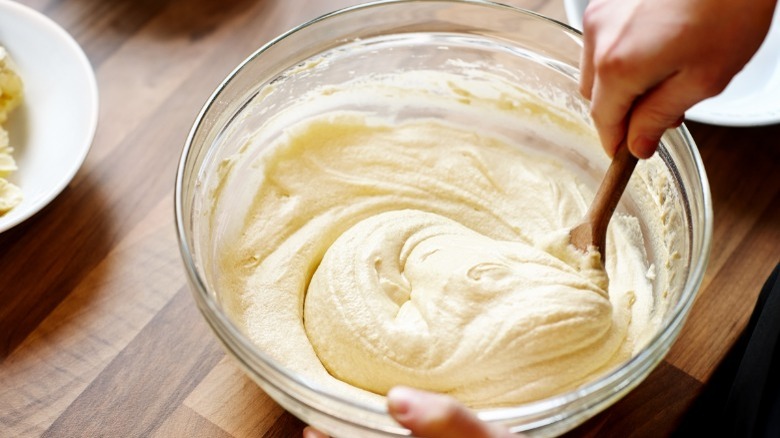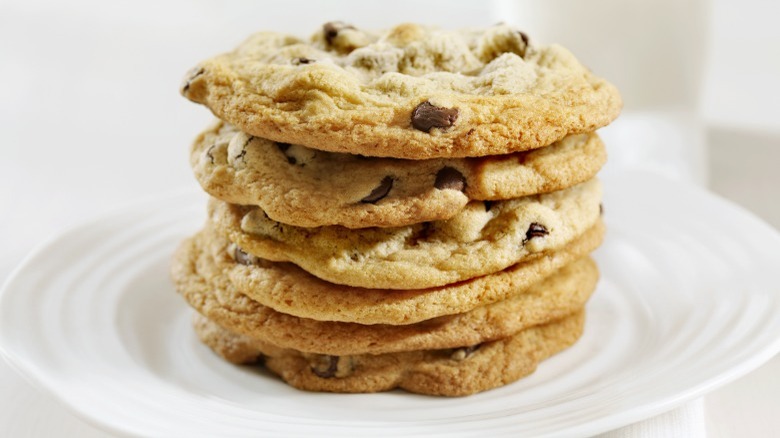For Light, Velvety Cakes, Try The Reverse Creaming Method
Creating the perfect cake batter is no easy feat, even if you follow a good recipe. Baking a cake can be temperamental, and achieving a result that's fluffy and light, but still packed with flavor, may take some trial and error. If your cakes sometimes end up dense or otherwise undesirable, try looking for a recipe that uses reverse creaming. This method for mixing cake batter is a little unconventional, but could be the key to finally baking a cake with a light and velvety crumb.
"Creaming" refers to the step in the caking-making process in which butter or fat is whipped together with sugar. This creates a pale yellow mixture that is often described as "fluffy and light." Reverse creaming is an alternative method that might seem a little backwards, at first glance. Instead of mixing together sugar and butter, the butter is incorporated into the dry ingredients (such as flour, sugar, and baking powder) first. After beating all of that together, you add the liquid ingredients and eggs.
Although the batter may start off looking a little odd — a bit like coarse, grainy sand — the final result will be creamy and smooth, producing perfectly fluffy cakes. A cake that's meant to be extra light and delicate, like a light and airy Chantilly cake, could benefit from the reverse creaming method, instead of the more traditional steps of mixing a batter.
The benefits of reverse creaming
An early version of the reverse creaming method can trace its origins back to the Betty Crocker company, and has continued to be popular among some bakers, but relatively unknown to others.Reverse creaming is a lot simpler than the traditional creaming method. Instead of having to individually mix sugar and butter, you only need to mix the butter with everything dry, then add everything that's wet, saving you a few extra dirty dishes and a bit of time, as well.
Reverse creaming is also proven to improve a cake's texture. When you add the butter directly to the dry ingredients, the flour becomes coated in fat. This extra coating reduces the development of gluten, the wheat protein that gives baked goods structure, but can make them more tough and chewy if present in large amounts. Too much gluten in a cake batter can make a cake dense and tough, so reverse creaming can help keep it soft and velvety.
Additionally, reverse creaming is perfect for tall layer cakes. Batter made using this method has less air incorporated into it, due to the lack of aeration that is normally created when creaming the butter and sugar. Your final product will stiff be soft and fluffy, but also a lot sturdier, perfect for cutting into layers and stacking into a layered chocolate cake, vanilla cake, or even carrot cake.
Reverse cream your cookie dough too
Reverse creaming isn't only advantageous when making cakes — it works wonders for cookie dough as well, if you're looking to create a crispy cookie. Baker Justine Doiron posted a video to her TikTok of a copycat recipe for Tate's Bake Shop-brand cookies. Her secret to achieving a thin and crunchy cookie, just like the brand's famous products, is reverse creaming.
In the normal process of making cookie dough, you cream together butter and sugar and beat air into these ingredients, just like in a cake batter. By using reverse creaming and mixing your butter directly into the sugar and flour, you get rid of the air that makes cookies thick and slightly "cakey," leaving you with a crunchier final product. Before adding liquid ingredients such as eggs and vanilla, Doiron's dough has a texture similar to that of sand, much like you would see when using the reverse creaming method for cake batter. After baking "low and slow," her copycat cookies look just like Tate's — round, flat, and crunchy.



